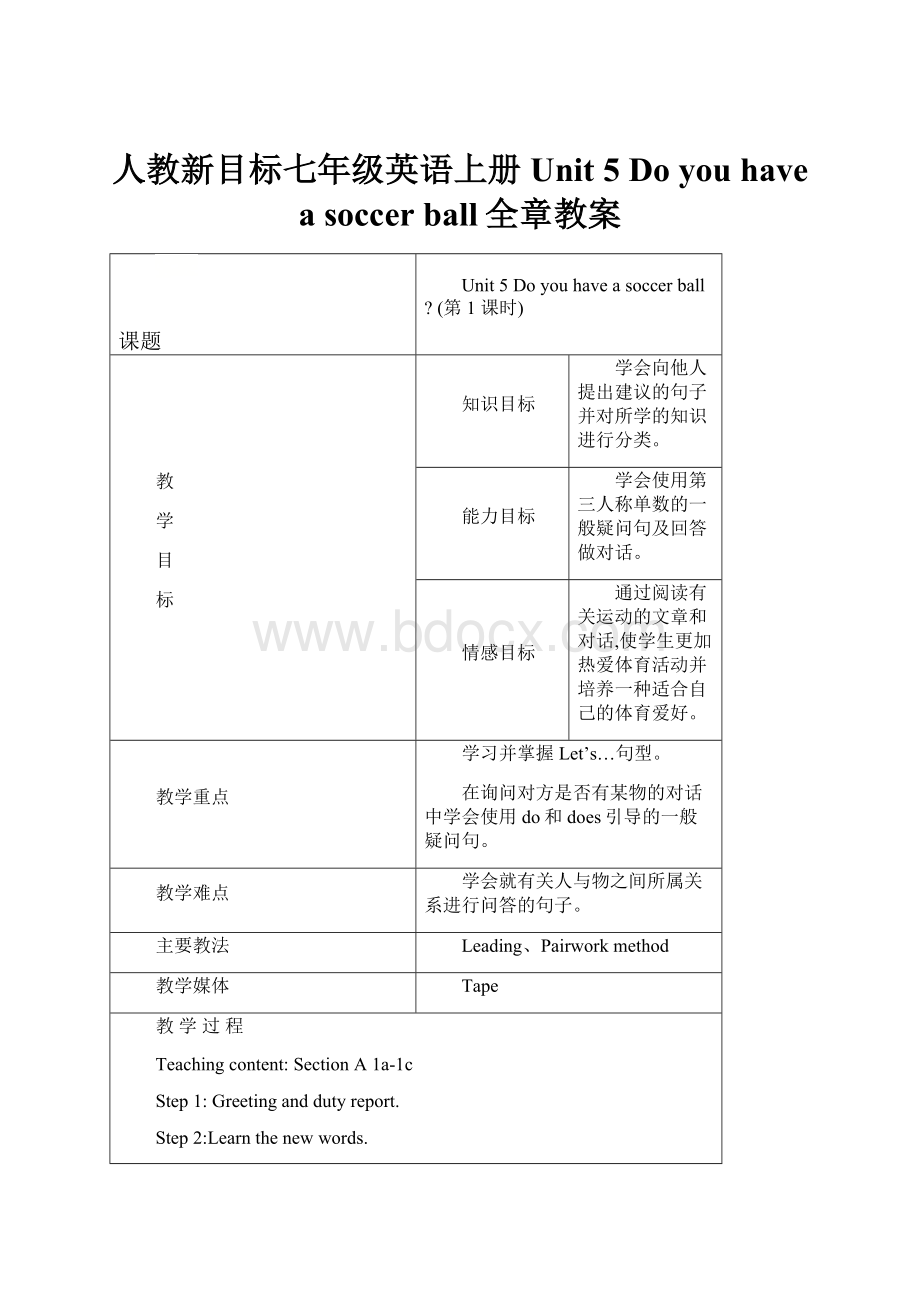人教新目标七年级英语上册Unit 5 Do you have a soccer ball全章教案.docx
《人教新目标七年级英语上册Unit 5 Do you have a soccer ball全章教案.docx》由会员分享,可在线阅读,更多相关《人教新目标七年级英语上册Unit 5 Do you have a soccer ball全章教案.docx(16页珍藏版)》请在冰豆网上搜索。

人教新目标七年级英语上册Unit5Doyouhaveasoccerball全章教案
课题
Unit5Doyouhaveasoccerball?
(第1课时)
教
学
目
标
知识目标
学会向他人提出建议的句子并对所学的知识进行分类。
能力目标
学会使用第三人称单数的一般疑问句及回答做对话。
情感目标
通过阅读有关运动的文章和对话,使学生更加热爱体育活动并培养一种适合自己的体育爱好。
教学重点
学习并掌握Let’s…句型。
在询问对方是否有某物的对话中学会使用do和does引导的一般疑问句。
教学难点
学会就有关人与物之间所属关系进行问答的句子。
主要教法
Leading、Pairworkmethod
教学媒体
Tape
教学过程
Teachingcontent:
SectionA1a-1c
Step1:
Greetinganddutyreport.
Step2:
Learnthenewwords.
1.Presentthekeyvocabulary.
(Showabasketballtotheclass.)
T:
What’sthisinEnglish?
S1:
It’sabasketball.
T:
Yes,youareright.Readafterme.B-A-S-K-E-T-A-B-L-L,basketball.
Ss:
B-A-S-K-E-T-A-B-L-L,basketball.
(Showthestudentsotherobjects.Teachthenewwords“tennisracket,ping-pongball,volleyball,basketball”inthesameway.Andthenshowstudentsthepictureoftelevisionandteachit.)
T:
Readthewordstogethertwice.
Ss:
…
T:
Askandanswerinpairswiththesethings.Usethedrill“What’sthisinEnglish?
”and“Whereisthe..?
”
2.Lookatthewordsin1aandmatchthewordswiththethingsinthepicture.
T:
Number1is(c),tennisracket.What’sNumber2Matchthem.
3.Askonestudenttoshowtheanswersandcheckthem.
Step3:
Presentthestructures.
1.Presentthesequestionsandanswers.
(Pointtoastudentwhohasapenorapencilcase.)
T:
Doyouhaveapencilcase?
S1:
Yes,Ido.(Nodyourheadyes)
T:
Doyouhaveacomputergame?
S1:
No,Idon’t.(Shakeyourheadno)
2.Practicethedrill“Doyouhavea…?
”inpairs.Youcanuseyourschoolthingsandtheseballs.Lookatthemodel,thenpracticelikethis.
Model:
Sa:
Doyouhaveabackpack?
Sb:
Yes,Ido.Doyouhaveasoccerball?
Sa:
No,Idon’t.Ihaveavolleyball.
(Studentsworkinpairs.)
Step4:
Listeningpractice.
T:
Lookatthefouritemsof1binthepictures.Listentotheconversation.
(Playtherecordingof1bthefirsttime.Studentsonlylisten.)
T:
Listentotheconversationandcirclethewordsyouhear.
(Playtherecordingagain.)
T:
Checktheiranswers.
S:
…
Step5:
Practicetheconversations.
1.Readtheconversationsin1c.
(Askstudentstorepeat.)
2.Lookatthepicturein1aandpracticetheconversationwitheachotherinpairs.
S1:
Doyouhave…?
S2:
Yes,Ido.
S1:
Doyouhavea…?
S2:
No,Idon’t.
3.Workingroupsoffourandusethepicturetopracticethesimilarconversationswiththenewwords.(television,basketball,baseballbat,soccerball,volleyball,television)
T:
Askandanswerthequestionsasmanyasyoucan.
S1:
Doyouhavea…?
S2:
…
S1:
…
S2:
…
Step6:
Task.
T:
Makeasurveyabout“Whatkindofballsdothestudentshave?
”Wewanttohaveaballgame.Butwedon’tknowwhatkindofballsyouhave.Pleaseaskyourclassmatesinthegroupwhatballshe/shehas.Thenwritedowntheinformationinthechart.
1.Fillinthechartusingthestructureandmodelsonthescreen.
Names
Doyouhave…?
Ballsyouhave
1
2
3
4
5
Structures:
Doyouhavea…?
Yes,Ido./No,Idon’t.
Whatballsdoyouhave?
Ihavea…
Example:
S1:
Doyouhaveatennisracket,Tom?
S2:
No,Idon’t.
S1:
Whatballsdoyouhave?
S2:
Ihavebasketballandfootball.
S1:
Whataboutyou?
S3:
…
2.Chooseonestudentfromeachgrouptoreportabouthisorhergroup.
Reportlikethis:
Sheorhelikes…Oneofthemhasa…Buttwoofthemhave…
StepSix:
Homework.
Makeasurveyaboutyourparents’collection.
Name
collection
Mother
father
Step7:
Homework.
1.NewwordsofP25.
2.Previewthenextperiod.
课
后
反
思
教学成败得失及改进设想:
整节课的教学氛围相当不错,达到了预期效果。
通过单词检测、对话练习和游戏等一系列学习手段,对所学知识进行系统而全面的练习,不仅使学生掌握所学知识,更重要的是灵活运用的能力。
课题
Unit5Doyouhaveasoccerball?
(第2课时)
教
学
目
标
知识目标
学会就有关人与物之间所属关系进行问答的句子。
能力目标
学会使用第三人称单数的一般疑问句及回答做对话。
情感目标
通过阅读有关运动的文章和对话,使学生更加热爱体育活动并培养一种适合自己的体育爱好。
教学重点
在询问对方是否有某物的对话中学会使用do和does引导的一般疑问句。
教学难点
学习并掌握Let’s…句型。
主要教法
Leading、Pairworkmethod
教学媒体
Tape
教学过程
Teachingcontent:
SectionA2a-4
Step1:
Greetinganddutyreport.
Step2:
Warmingup.
1.Presentthenewstructures.
2.Practicethedrill.
T:
Practiceingroupsoffour.Thefirsttwostudentsmustusethedrill“Doyouhavea…?
”Theothertwostudentsaskandansweraccordingtotheirconversationandusethedrill“Doeshe/shehavea…?
”
S1:
Doyouhavea…?
S2:
Yes,Ido.Doyouhavea…?
S1:
No,Idon’t.
S3:
Doesshehavea…?
S4:
Yes,shedoes.Doeshehavea…?
S3:
No,hedoesn’t.
Step3:
Listening.
T:
Lookatthepicturesin2bandnamethem.Whatarethese?
(Pointatthebaseball,basketball,volleyball,football.)
Ss:
Theyare…
T:
Therearefourchildrenintheconversations.Whoarethey?
Pleaselistenandfindtheanswer.
(Playtherecorderforthefirsttime.)
S:
…
T:
I’llplaytherecorderforthesecondtime.Listenandnumberthepictures(1-4).
(Studentslistenforthesecondtime.)
T:
Listentotheconversationin2b.Matchthepeoplewiththeballs.
(Studentslistenandmatch.Teachercheckstheiranswer.)
Step4:
Practicethestructure:
Doyouhavea…?
Yes,Ido./No,Idon’t.
Step5:
Learnhowtomakesuggestions.
1.Presentthenewword:
Let’s…
Theteacherwritesthedrillonthebackboard.
A:
Let’splay…
B:
No,Idon’thavea…
A:
Well,let’splaybaseball.
B:
Thatsoundsgood.
T:
“Thatsoundsgood”means“ThatisagoodideaorThatwouldbefun”.
2.Do3a.
(Theteacherreadsthecartoonstoryin3aforstudents,sayingblankeachtimeyoucometoanemptywrite-online.
T:
I’llaskastudenttoreadthefourwordstotheclass.
S:
…
T:
Fillintheblankswiththewordsfromthebox.
(Studentsworkaloneastheywritethefourwordsfromtheboxinthecorrectbanks.)
T:
Checktheanswers.
S:
..
Step6:
Practicethestructure:
Let’s…
1.Explaining.
T:
Lookatthethreepicturesin3bandnamethethingsinit.
S:
…
T:
WhatdoesthemarkonthebasketballinPictureOnemean?
Themarkmeans“don’t”or“no”andmeans“doit”.
T:
Whoreadtheconversationinpairs?
S:
…
2.Pairwork.
T:
Makeconversationswithyourpartneraccordingtothepicture.
Sa:
Let’splaybaseball.
Sb:
Idon’thavea…
Sa:
Well,let’splay…
Sb:
…
Step7:
Task.
JointheSchoolSportCenter.
T:
Lookatthead.Onthescreen.Whatsportsdoyouliketoplay?
Whoareyourfavoritesportsmenandsportswomen?
Whatsportsdoyouplayattheschool?
OurschoolhasaSportsCenterwithallthesportsthatyouwouldliketoplay.
WelcometoourSportsCenter.
Doyoulikesports?
Wehavemany
Clubs:
volleyball,basketball,ping-pongandmore.Joinus.
1.Readthead.andfillinthechart.
2.Readthead.forstudentsandaskthemtorepeatthenewwords.
3.Askstudentstochooseoneclubandfillintheform.
4.Makeaconversationwithonestudentusingtheform.
Structures:
What’syourfirstname?
What’syourlastname?
Whatsportsdoyoulike?
Doyoulike…?
Whatclassareyouin?
Howoldareyou?
Application(申请)
Firstname
Lastname
Age
Sex
Class
Club
5.Changethepartnerandmakeanotherconversation.
Structures:
Whatsportsdoeshelike?
Doeshe/shelike…?
课
后
反
思
教学成败得失及改进设想:
整节课的教学氛围相当不错,学生能够积极配合教师进行Pairwork和Groupwork活动,但学生在使用do和does引导的一般疑问句时,仍未理解透彻,下节课应加强这方面的引导和训练。
课题
Unit5Doyouhaveasoccerball?
(第3课时)
教
学
目
标
知识目标
学会就有关人与物之间所属关系进行问答的句子。
能力目标
学会使用第三人称单数的一般疑问句及回答做对话。
情感目标
通过阅读有关运动的文章和对话,使学生更加热爱体育活动并培养一种适合自己的体育爱好。
教学重点
在询问对方是否有某物的对话中学会使用do和does引导的一般疑问句。
学会用祈使句来向对方提出建议。
教学难点
学习并掌握Let’s…句型。
学会用祈使句询问某人是否有某物。
主要教法
Leading、Pairworkmethod
教学媒体
Tape
教学过程
Teachingcontent:
SectionB1a-2c
Step1:
Greetinganddutyreport.
Step2:
Warmingup.
1.Presentthestructureoflastlesson.
(showavolleyballtoastudent)
T:
Let’smakeaconversationaboutyoursportyoulike.Doyoulikevolleyball?
S1:
Yes,Ilikeitverymuch.
(Showabaseballtohimorher.)
T:
Whataboutbaseball?
S1:
No,Idon’t.Idon’tlikeit.
T:
OK.Let’splayvolleyballafterclass.
S1:
Great.
2.Workinpairsandmakeasimilarconversationlikethis.
Step3:
Learnthenewwords.
1.Readthewordsin1a.
(Pointtothefivewordsin1aandaskstudentstorepeateachone.)
Ss:
interesting,fun,relaxing,boring,difficult.
2.ExplaintheChinesemeaningofthem.
3.Thenmatcheachpicturewithoneofthewords.
(Pointtothefivepicturesandaskstudentstomatchthem.)
4.Correcttheanswer.
Step4:
Practicethenewwords.
1.Askandanswerusingthedescriptionwordslikethis.
(Writethelistofthesubjectstodayontheblackboard.Teacherpointstothesubjects.Studentssaythedescriptionwords.)
T:
Ismathrelaxing?
Ss:
No,it’sboring.
T:
Nowworkinpairs.
2.Practiceusingyourpictures.
T:
Pleasedrawpicturesthatshowsomethinginteresting,boring,fun,difficultorrelaxing.Thenmakeconversations.Doitlikethis.
(DrawthepicturesofaTVandafootballontheblackboard.)
T:
DoyouwatchTV?
S1:
Yes.Ilikeit.
T:
Isitinteresting?
S1:
Yes,it’sveryinteresting.
T:
Doyouhaveafootball?
S1:
Yes,Ido.
T:
Isitfun?
S1:
Yes,it’sfun.AndIlikeit,too.
(Askafewstudentstodrawandanswerit.)
3.Changepicturesandworkinpairs.
T:
Nowpleasechangeyourpartnerandworkinpairs.Trytoguesswhichofthefivewordsthepictureshows.
Step5:
Listening(2a).
1.Onestudentreadthefivewordsin1aabovetotheclass.
T:
Nextwe’lllistentoaconversation.Herearetwoboysintheconversation.Whatdotheywanttodo?
Listen.
2.Studentsonlylisten.
(Playtherecordingthefirsttime.)
3.Listenagainandcheckthewordsyouhearin1a.
(Playtherecordingagain.)
4.Checktheanswers.
Step6:
Listening(2b).
T:
Practiceinrecognizingspecificvocabularywordsinconversationandinwritingthem.First,listentotherecordingin2b.WhatdoesTonysayabouttheactivities?
(Pointtotheblankswherethestuden